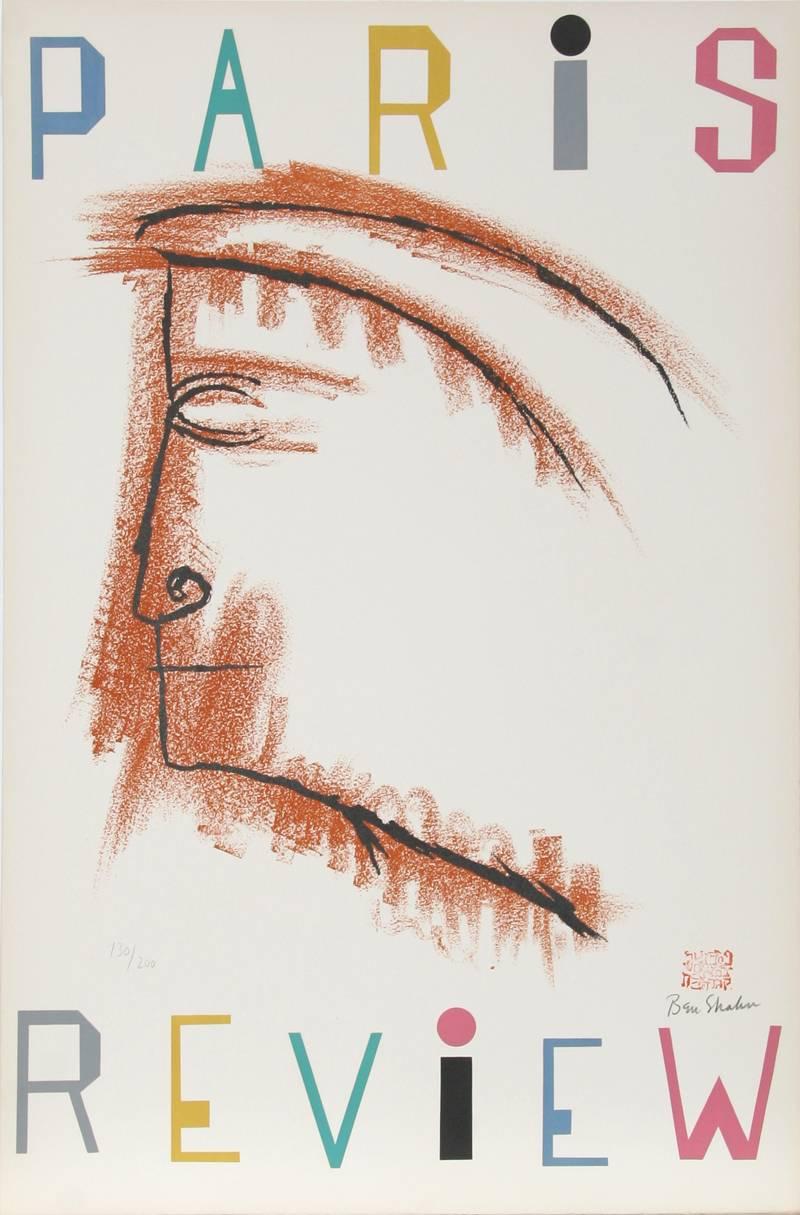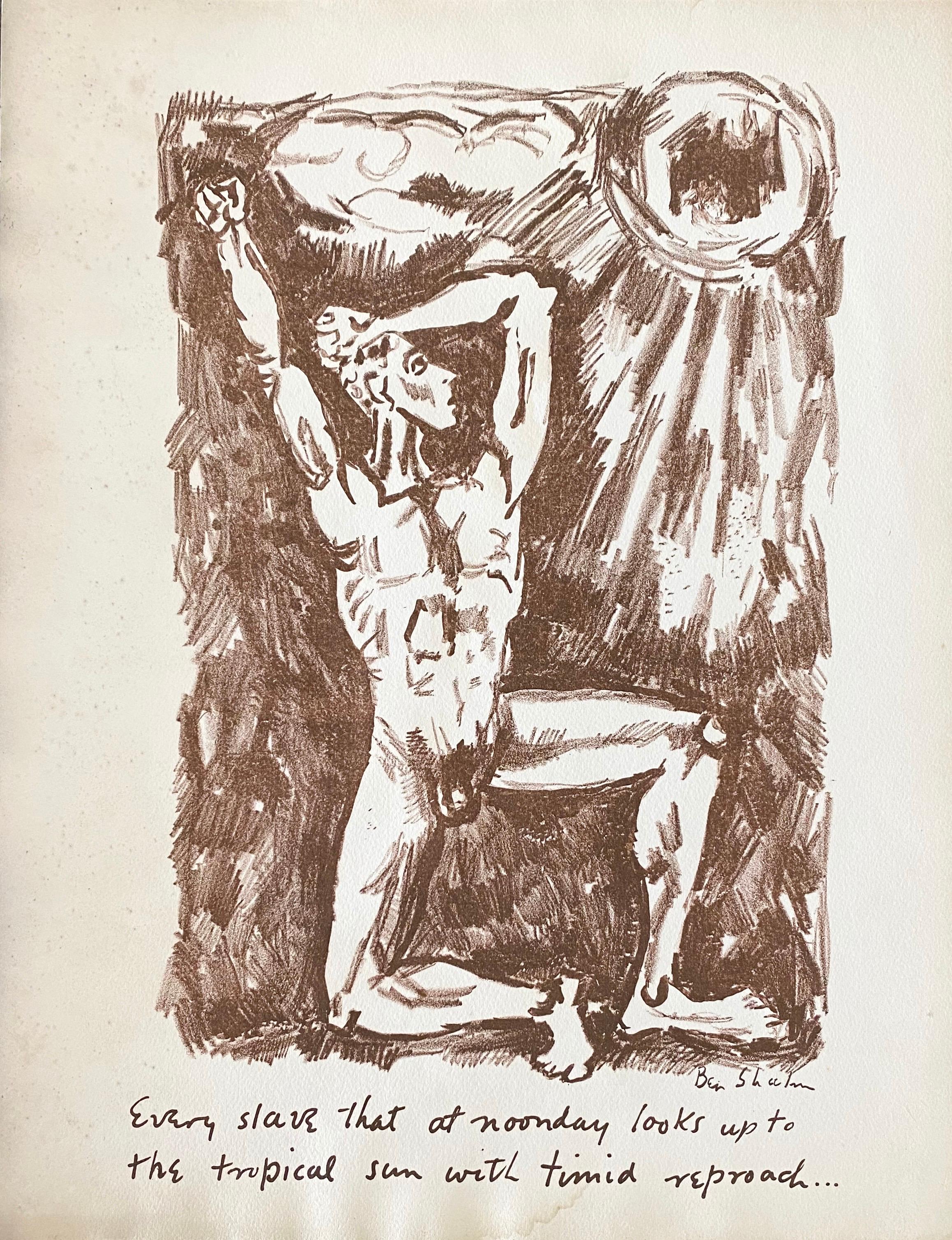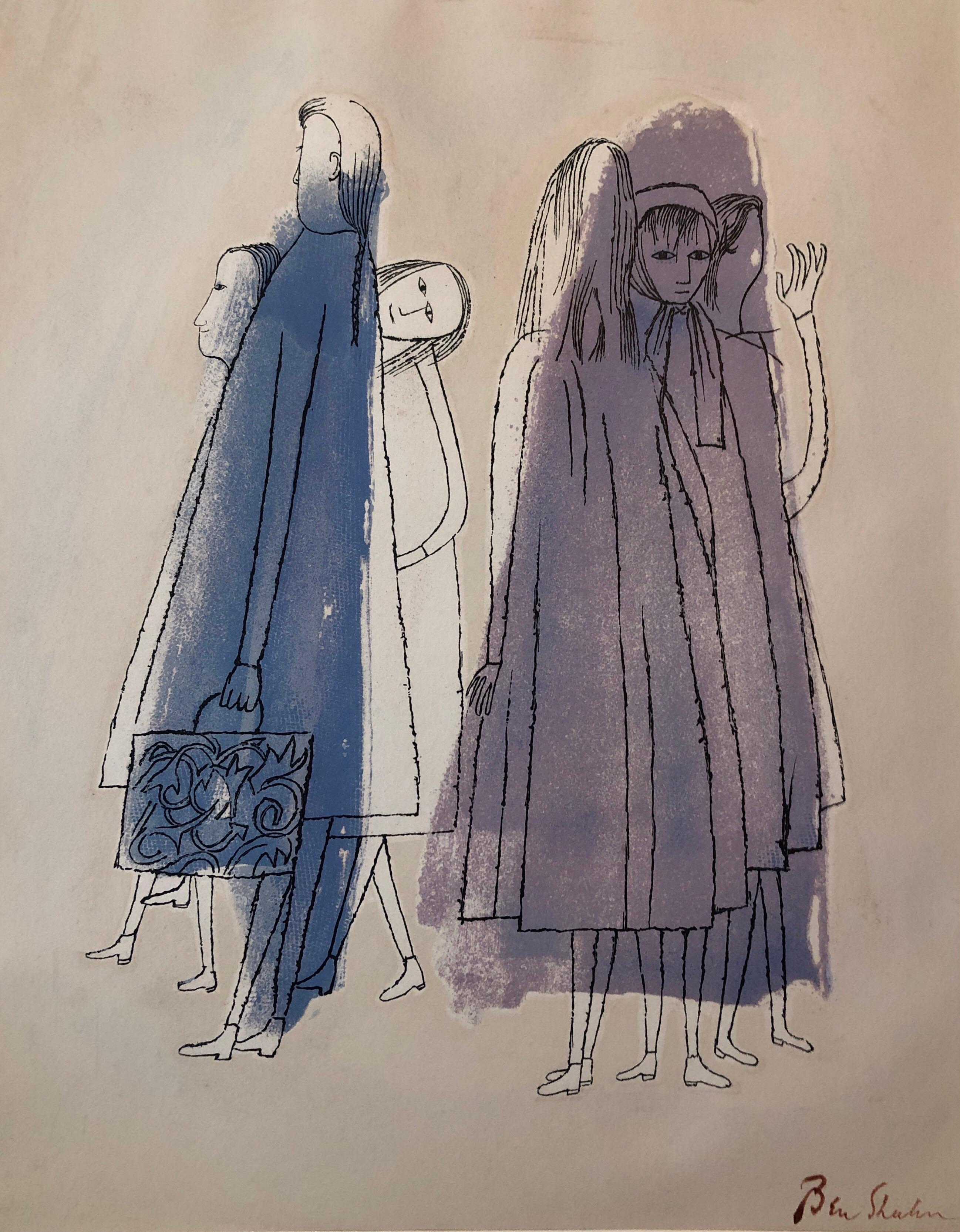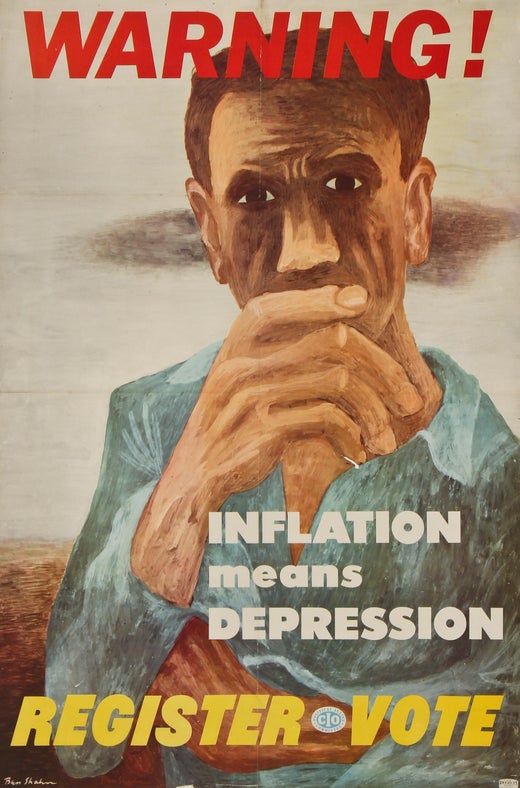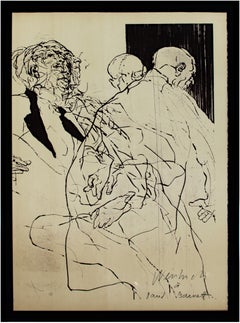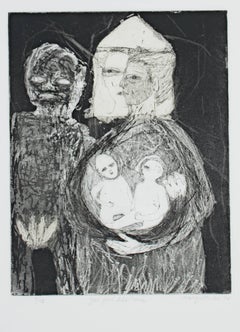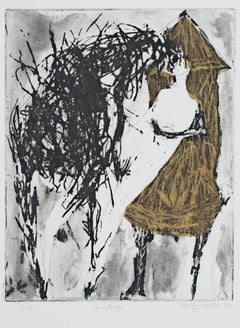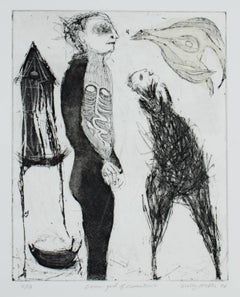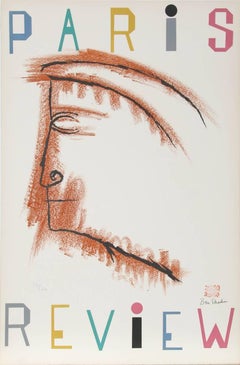Items Similar to "Beside the Dying, " an Original Lithograph signed by Ben Shahn
Want more images or videos?
Request additional images or videos from the seller
1 of 9
Ben Shahn"Beside the Dying, " an Original Lithograph signed by Ben Shahn1968
1968
$3,200
£2,481.19
€2,815.37
CA$4,587.06
A$4,987.78
CHF 2,628.07
MX$60,587.02
NOK 33,040.17
SEK 30,972.49
DKK 21,126.89
About the Item
"Beside the Dying" is an original signed lithograph by Ben Shahn. This print is from the series "For the Sake of a Single Verse" and depicts the head of a man in dark gray seemingly asleep or dead on a white background. It is signed lower right and is edition 27/200.
22" x 17" art
32 3/8" x 27 3/8" frame
Ben Shahn (American, September 12, 1898 - March 14, 1969) was a painter, lithographer, and photographer best known for his left-wing political leanings, works of social realism, and The Shape of Content, a publication of his lectures. Shahn was born in Kovno, Lithuania, when the country was still occupied by the Russian Empire. In 1902, Shahn's father, Joshua Hessel, was exiled to Siberia. Shahn then moved to Vilkomir, Lithuania, with his mother, Gittel, and his two siblings. Their family moved to the United States in 1906 to join their father who had fled from exile. After settling in Brooklyn, NY, Shahn began to train in lithography and graphic design, and his favorite medium was egg tempera. In 1919, Shahn enrolled in New York University to study Biology before entering the City College in 1921 to study Art. He also studied Art at the National Academy of Design. In the 1920s, Shahn and his wife traveled around Africa and Europe to study the works of renowned artists such as Pablo Picasso (Spanish, 1881- 1973) and Raoul Dufy (French, 1877-1953).
In 1933, Shahn worked as an assistant of Diego Rivera (Mexican, 1886 - 1957); at this time, Rivera was working on the mural at the Rockefeller Center in New York. Two years later, Shahn was recommended by Walker Evans (American, 1903 - 1975) to join the Farm Security Administration photographic group. One of the artist’s most famous works is the fresco mural he did for the Jersey Homesteads' community center. Shahn also worked on murals for the state on the Federal Security Building and the Bronx Central Annex Post Office.
During the Second World War, Shahn made a series of paintings laced with anti-war sentiments. An example of his work during this period is Death on the Beach. Shahn's famous portrait of Martin Luther King, Jr. is an example of work he did commercially for Time. He also did commercial works for CBS, Fortune, and Harper's. In 1954, Shahn represented the United States at the Venice Biennale alongside Willem de Kooning (Dutch, 1904 - 1997).
In the last two decades of his life, Shahn was active in academics and received honorary doctorates from several universities, such as Princeton University in Princeton, NY, and Harvard University in Cambridge, MA. He had exhibited at institutions including Edith Halpert's Downtown Gallery in New York, NY, in 1930, and New Jersey State Museum, in Trenton, in 1969. His works can be found in numerous galleries, including the Museum of Modern Art, New York, and the National Gallery of Australia, Canberra. Shahn died in New York in 1969.
- Creator:Ben Shahn (1898-1969, American)
- Creation Year:1968
- Dimensions:Height: 32.375 in (82.24 cm)Width: 27.375 in (69.54 cm)
- Medium:
- Period:
- Condition:
- Gallery Location:Milwaukee, WI
- Reference Number:Seller: 5144g1stDibs: LU60532189473
Ben Shahn
Ben Shahn (1898 – 1969) was a Lithuanian-born American artist. He is best known for his works of social realism, his left-wing political views, and his series of lectures published as The Shape of Content. Shahn began his path to becoming an artist in New York, where he was first trained as a lithographer. Shahn's early experiences with lithography and graphic design is apparent in his later prints and paintings which often include the combination of text and image. Shahn's primary medium was egg tempera, popular among social realists. Shahn mixed different genres of art. His body of art is distinctive for its lack of traditional landscapes, still lifes, and portraits. Shahn used both expressive and precise visual languages, which he coalesced through the consistency of his authoritative line. Shahn is also noted for his use of unique symbolism, which is often compared to the imagery in Paul Klee's drawings. His art is striking but also introspective. He often captured figures engrossed in their own worlds. Although he used many mediums, his pieces are consistently thoughtful and playful.
About the Seller
4.9
Gold Seller
Premium sellers maintaining a 4.3+ rating and 24-hour response times
Established in 1966
1stDibs seller since 2017
452 sales on 1stDibs
Typical response time: 2 hours
- ShippingRetrieving quote...Shipping from: Milwaukee, WI
- Return Policy
Authenticity Guarantee
In the unlikely event there’s an issue with an item’s authenticity, contact us within 1 year for a full refund. DetailsMoney-Back Guarantee
If your item is not as described, is damaged in transit, or does not arrive, contact us within 7 days for a full refund. Details24-Hour Cancellation
You have a 24-hour grace period in which to reconsider your purchase, with no questions asked.Vetted Professional Sellers
Our world-class sellers must adhere to strict standards for service and quality, maintaining the integrity of our listings.Price-Match Guarantee
If you find that a seller listed the same item for a lower price elsewhere, we’ll match it.Trusted Global Delivery
Our best-in-class carrier network provides specialized shipping options worldwide, including custom delivery.More From This Seller
View All'Il bouge sans arrêt' original signed lithograph poster after drypoint, 1960s
By Claude Weisbuch
Located in Milwaukee, WI
This poster is a lithographic enlargement of the dry point print 'Il bouge sans arrêt' by the French artist Claude Weisbuch. The image is an early example of his explorations into th...
Category
1960s Contemporary Figurative Prints
Materials
Lithograph
"You Feel Like Home, " an Etching & Aquatint signed by Molly McKee
By Molly McKee
Located in Milwaukee, WI
"You Feel Like Home" is an original etching and aquatint signed by the artist Molly McKee. It is edition 3/10 and depicts a figure holding two babies and another tall figure to the l...
Category
1990s Expressionist Figurative Prints
Materials
Etching, Aquatint
"Hinting (With Chine Colle), " Etching & Aquatint signed by Molly McKee
By Molly McKee
Located in Milwaukee, WI
"Hinting" is an original etching and aquatint made with Chine Colle by Molly McKee. The artist signed the piece in the lower right, titled it lower center, and wrote the edition numb...
Category
1990s Surrealist Figurative Prints
Materials
Etching, Aquatint
"Demi-God of Discontent, " Original Etching and Aquatint signed by Molly McKee
By Molly McKee
Located in Milwaukee, WI
"Demi-God of Discontent" is an original etching and aquatint made with Chine Colle by Molly McKee. The artist signed the piece in the lower right, titled it lower center, and wrote the edition number (2/10) in the lower left. It depicts a few abstracted human figures in McKee's surreal and horror-inspired style.
11 3/4" x 9" art
24 7/8" x 17 1/2" frame
This surreal etching...
Category
1990s Surrealist Figurative Prints
Materials
Etching, Aquatint
"From the Series Cheval et Chevalier, " a Lithograph signed by Marino Marini
By Marino Marini
Located in Milwaukee, WI
"From the Series Cheval et Chevalier" is an original color lithograph signed in the lower right by the artist, Marino Marini. It depicts three red abstracted horses and their riders ...
Category
1970s Post-Modern Animal Prints
Materials
Lithograph
"Hinting (With Chine Colle), " Etching & Aquatint signed by Molly McKee
By Molly McKee
Located in Milwaukee, WI
"Hinting (With Chine Colle)" is an etching and an aquatint signed by Molly McKee. This complex print starts with a mass of black scribbles that are in the foreground near the upper left. The next piece is a woman's torso. Covered up slightly by the black marks, but still beautiful and graceful. Behind her is a golden rocket shaped object.
Art: 12 x 8.88 in
Frame: 24.88 x 17.5 in
A Milwaukee...
Category
1990s Surrealist Abstract Prints
Materials
Etching, Aquatint
You May Also Like
Beside the Dying from the Rilke Portfolio, Ben Shahn
By Ben Shahn
Located in Long Island City, NY
Artist: Ben Shahn, American (1898 - 1969)
Title: Beside the Dying from the Rilke Portfolio
Year: 1968
Medium: Lithograph, signed in the plate
Edition: 750
Size: 22.5 x 17.75 in. (57...
Category
1960s Modern Figurative Prints
Materials
Lithograph
Beside the Dead from the Rilke Portfolio, Lithograph by Ben Shahn
By Ben Shahn
Located in Long Island City, NY
Artist: Ben Shahn, American (1898 - 1969)
Title: Beside the Dead from the Rilke Portfolio
Year: 1968
Medium: Lithograph, signed in the plate
Edition: 750
Size: 22.5 x 17.75 in. (57....
Category
1960s Modern Figurative Prints
Materials
Lithograph
Paris Review, Modern Art Lithograph by Ben Shahn
By Ben Shahn
Located in Long Island City, NY
Artist: Ben Shahn, American (1898 - 1969)
Title: Paris Review
Year: 1968
Medium: Lithograph on Arches, Signed in black crayon, numbered in pencil
Edition: 200
Paper Size: 39 x 26 in....
Category
1960s American Modern Figurative Prints
Materials
Lithograph
Partings Long Seen Coming from the Rilke Portfolio
By Ben Shahn
Located in Long Island City, NY
Artist: Ben Shahn, American (1898 - 1969)
Title: Partings Long Seen Coming from the Rilke Portfolio
Year: 1968
Medium: Lithograph on Richard de Bas, si...
Category
1960s American Realist Figurative Prints
Materials
Lithograph
Ben Shahn Original Lithograph From Portfolio - Levana & Our Ladies Of Sorrow
By Ben Shahn
Located in Surfside, FL
SCARCE EARLY WORK. BEN SHAHN
Levana and our Lady's Sorrows.
lithograph printed in sepia on Papier Ancien, 1931. 13 1/8x9 7/8 inches (sheets), full margins, loose as issued.
One of o...
Category
Mid-20th Century American Modern Figurative Prints
Materials
Lithograph
Ben Shahn Original Hand Signed Litho WPA Artist Rilke Poem Lithograph Portfolio
By Ben Shahn
Located in Surfside, FL
"To Days of Childhood That are Still Unexplained". It depicts six female silhouette figures in long dresses or coats against a blue and pastel purple background. From the Rainier Ma...
Category
1950s American Modern Figurative Prints
Materials
Lithograph
More Ways To Browse
Salvador Dali Signed Lithograph Card Series
Shepard Black Sabbath
Shepard Fairey Hope
Shepard Fairey Ruth
Tarkay Giclee
Walter Lees
Warhol Margrethe
Warhol Playboy
Warhol Witch
Alex Katz Brisk Day
Alex Katz Ulla
Andre Level
Andy Warhol Birth Of Venus
Andy Warhol Greta Garbo
Andy Warhol Kachina Dolls 381
Andy Warhol Lenin
Andy Warhol Mata Hari
Andy Warhol Sitting Bull
